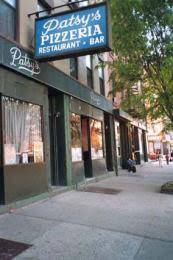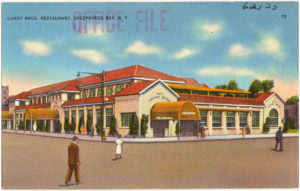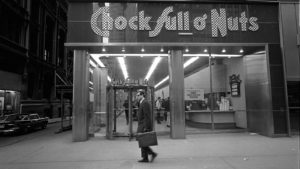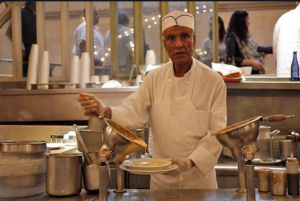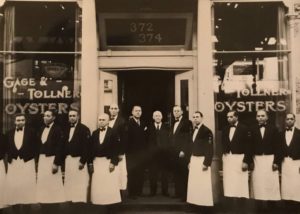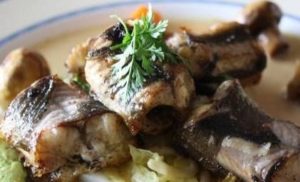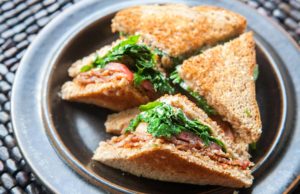When HG was a New York journalist (1950-1955), a favorite restaurant of HG and HG’s newspaper and wire service pals was Patsy’s. It was located in an edgy neighborhood of Spanish Harlem, 2287 First Avenue (west side of the Avenue between 117th and 118th Streets). Many junkies and drug pushers in the neighboring streets. Since junkies needed money for their next fix, muggings were frequent. The restaurant was a neighborhood fixture and its pizzas (made in an ancient coal fired oven) were remarkable. It was very affordable. HG’s meal of crudo di vongole (clams on the half shell) and linguine aglio e olio (olive oil, garlic, parsley and a sprinkle of red pepper) cost less than two dollars. Sometime in the early 80’s HG took a group of friends there after a Gerard Schwartz concert at the 92nd Street Y. Restaurant was a bit run down and the neighborhood made much of the group nervous. Gerry Schwartz enjoyed the odd place and all agreed the food was terrific. At some juncture in the 1980s, Woody Allen stopped by Patsy’s with associates and raved about the food. Voila!! Patsy’ became a hangout for cool New Yorkers. (Rao’s, the super exclusive red sauce restaurant, is close to Patsy’s at 114th Street and Pleasant Avenue). Patsy’s is still in business. Prices are modest (by Manhattan standards). The clams are now $8.50 and the linguine is $9.95. The neighborhood is much improved if not totally gentrified.
Patsy’s: East Harlem
May 16th, 2021 § 0 comments § permalink
Lundy’s: Triumph and Tragedy
September 17th, 2020 § 0 comments § permalink
Lundy’s, located on Emmons Avenue in the Brooklyn neighborhood of Sheepshead Bay, had a long run: 1935-1977 (the effort to revive it in the 90’s failed). It seated almost 2,000 diners. Despite the vast size, it served consistently perfect food with efficient, swift service (by long tenured African-American waiters similar to those at Gage & Tollner, another Brooklyn landmark). In HG’s opinion, this was the best seafood restaurant in the world. It was affordable. In the late 1940’s and early 1950’s, a glass of beer was 15 cents and a dry Martini was 45 cents. The “Shore Dinner” was vast: raw clams (or shrimp); oysters on the half shell; steamers; half a broiled lobster and half a roast chicken; French fries; cole slaw; lots of hot, buttered biscuits; pie (huckleberry was the best); coffee. HG would share one shore dinner with HG’s Brooklyn girlfriend. In the immediate post-World War Two years, the shore dinner cost $5.00. HG usually ate more modestly at Lundy’s. Five bucks was a splurge, so economic-minded HG often patronized the restaurant’s raw clam bar. One dozen little necks and one dozen cherry stones accompanied by warm, light-as-a-feather biscuits, dripping with melted butter. Icy Ballantine’s Ale. Nice snack and it cost in the neighborhood of two dollars. Lundy’s was founded by Irving Lundy and despite the financial success of the restaurant, the family was marked by tragedy. Early deaths from accidents, disease, and robbery-related murders.
Chock Full O’ Nuts
September 15th, 2020 § 1 comment § permalink
Chock Full O’ Nuts, the fast-food chain (at one time with 80 stores in New York) served excellent coffee and a signature sandwich of cream cheese and chopped nuts on dark raisin bread. During HG’s busy New York/New Jersey public relations career, it was a favorite stop for a quick lunch or afternoon snack (very superior whole wheat donuts among other menu items). Very efficient. Very clean (“Untouched by Human Hands” was its motto). Surly, grumpy African-American women were the servers and they used tongs to deliver the food. Jackie Robinson, after his retirement from baseball, was hired as personnel and general manager. He did his best to make the service friendlier. Chock Full was founded by William Black starting with theatrical district nut shops in the 1920’s. When the Great Depression hit, Black converted them into sandwich shops, selling the nutted cheese sandwich and a cup of coffee for five cents. Chock Full coffee was very good. When Gault Millau, French food critics, visited New York, they enjoyed the coffee and added that it was an effective laxative. Canned Chock Full was distributed in supermarkets. The singing commercial (by Black’s wife, Page Morton)–“Chock Full O’Nuts, that heavenly coffee, better coffee a Rockefeller’s money can’t buy”–was omnipresent on radio. The food chain closed down in the 1970’s. The coffee brand was sold to the Zanetti coffee conglomerate. The stores were revived in 2010 as Chock Full O’Nuts Cafes (there are now six, two in Brooklyn, two in New Jersey and two in upstate New York). The nutted cheese sandwich costs $4.95. A frankfurter, the same.
Jews. Chinese Food. Welcoming China.
September 9th, 2020 § 0 comments § permalink
Yes, Jews are very fond of Chinese food. Some believe that affection started at the time of the great 1900’s migration of Jews to New York from Eastern Europe. The lower east side neighborhood housed the incoming Jews in tenements and Chinatown was a short walk away. Chinatown food was cheap and tasty. Jews were not disdained because of their struggles with English. The Chinese were having their own problems. When HG was growing up, every neighborhood in the boroughs had Chinese restaurants. Chow mein and chop suey (heavy on the corn starch) were featured. HG and teenage Brooklyn girlfriend would feast on chow mein after a movie date. Dinner (Won Ton Soup, Chow Mein, Almond Cookie dessert, much tea) cost 50 cents. Mimi Sheraton, the distinguished food/restaurant writer, has recalled with nostalgic pleasure the comfort of celery, onion and bean sprout chow mein during her young Brooklyn days. HG/BSK’s first date more than 57 years ago was, of course, at a Chinatown restaurant: BoBo’s. The very good restaurant (long closed) was owned and run by a beautiful Chinese actress. Recently, HG discovered another reason for the Jewish affinity for Chinese food. In Simon Schama’s magisterial book, “The Story of the Jews: 1492-1900”, the historian traces the hundreds of years presence of Jews in China (Marco Polo, in 1286, commented on Jewish traders in China). Schama writes that there was a community of 2,000 Jews (with a synagogue, Torah, etc.) in the city of Kaifeng during the 1600’s and before. These Jews adopted Chinese names (along with their Hebrew names) and worked at scores of occupations (there were some prominent Jewish military leaders). Jews (and the Torah) were sympathetic to Confucian teachings while retaining their own identity. The Ming Emperors welcomed Jews to their land. Schama writes: “In China, Jews were not subjected to violence and persecution, not demonized as God killers. Their synagogues were not invaded by conversion harangues. They were not physically segregated from non-Jews, forced to wear humiliating forms of identification on their dress. They were not forced into the most degraded and despised occupations, not stigmatized as grasping and vindictive, and portrayed neither as predatory monsters nor pathetic victims.” A Seng emperor welcomed Jews with these words: “Come to our China: honour and preserve the customs of your ancestors, stay here and hand them down through the generations.” Can the Jewish love of Chinese food be linked to the unconscious memories of Jewish life in a benevolent China? Possibly.
Fifth Avenue Department Stores
September 20th, 2019 § 0 comments § permalink
When HG lived in Manhattan during the 1950’s and ’60’s, New York’s Fifth Avenue was lined with department stores and women’s fashion emporiums. Bergdorf Goodman (still there as it has been for more than 100 years) was at the corner of 57th Street with Tiffany’s (still there) and Bonwit Teller (gone) across the street. The fashion parade continued with I. Miller Shoes (gone), BSK’s fave for classy footwear; DePinna (gone), excellent men’s suits, shirts and ties; Best & Co. (gone), famed for women’s gloves; Saks Fifth Avenue (still operating and flourishing). To the dismay of folks who wanted to preserve the avenue’s elegant image, E.J. Korvette (gone), the pioneer discounter, opened on Fifth (it was where HG bought a bargain TV). South of 42nd Street, there was Franklin Simon (where BSK bought a lovely hat for the HG/BSK wedding reception at the St. Regis Hotel); Arnold Constable, Lane Bryant (for the ample lady); Lord & Taylor; W.J. Sloane Furniture; Russek’s (the great photographer, Diane Arbus, was from the family who owned the fashion store). B. Altman was on the corner of 34th Street and Fifth. Ohrbach’s was nearby on the north side of 34th. All have vanished and some of the luster that made Fifth Avenue unique. However, keeping avenue elegance alive are Van Cleef & Arpels (744 Fifth) and Cartier (653 Fifth), the jewelry and watch shops much patronized by New York’s new generation of wealth and oligarch tourists. Many of the department stores had pleasant lunchrooms. The best was at B. Altman. And, HG often had a steaming bowl of soup at Lord & Taylor.
Failure
September 14th, 2019 § 0 comments § permalink
HG has happy memories of perfect New York meals. At Veau D’or: Brains in back butter preceded by sausage with warm potato salad. At The Russian Tearoom: Blini with red caviar, melted butter and sour cream preceded by borscht. At Paul & Jimmy’s: Poached striped bass in brodo with a starter of linguine with white clam sauce. At Christ Cella: Lump crab meat cocktail, New York strip steak, Roquefort cheese salad. At Gitlitz Delicatessen: Pastrami and chopped liver on rye with coleslaw, Russian dressing and pickles. At Delsomma: Penne in broccoli sauce, pork chops with vinegar peppers and potatoes. At Fornos: Margaritas and roast pork with Spanish potatoes and broiled bananas. At Luchow’s: Pfefferlinge (wild mushroom fricasee) and Schlemershnitte (steak tartar covered in Beluga caviar). Blue Ribbon: Grilled bratwurst with sauerkraut and home fries followed by apple pancake. Artist & Writers: Dry martinis and koenigberger klops (meatballs in a dill and sour cream sauce). Paramount Dairy: Warm gefilte fish in fish broth and kashe varnishkes with mushroom and onion gravy. Nom Wah (of yesteryear): Dim sum. (HG has written about HG’s perfect meals at Gage & Tollner in a previous post). These are all joyous meals but they pale compared to the meal HG would relish often at the counter of the Grand Central Oyster Bar. Eight chilled oysters on the half shell. Oyster Pan Roast. Nesselrode pie. The pan roast was prepared behind the counter in a special pot by a dour, unsmiling older Italian. It was incomparable, redolent of the sea and the richness of farmland. For years, HG/BSK have tried to replicate this dish. The ingredients and cooking technique are simple. However, HG/BSK have always failed. Their attempts created a pallid dish, in no way comparable to the Oyster Bar wonder. HG tried again last night using big, plump Red Head Select oysters. The result: FAILURE.
Gage & Tollner
September 3rd, 2019 § 0 comments § permalink
HG has often been asked to name a favorite restaurant. The answer is simple: The long closed Gage & Tollner on Fulton Street in downtown Brooklyn. The restaurant had a long run, 1879 to 2004. The interior featured dark wood panelling, patches of stained glass and colorful tiles. Gentle, flattering gas lamp lighting. The waitpersons, mainly dignified, courtly African-American males, were Gage & Tollner veterans, their years of service marked by bars on their uniforms. The menu tilted toward seafood but also had world class steaks and chops. HG always started the HG meal with either oysters or little neck clams on the half shell. Followed by incomparable “clam bellies” sauteed in butter. Main dish was a tender, medium rare mutton chop accompanied by corn fritters. In the spring, HG enjoyed shad and shad roe with crisp bacon and boiled potatoes. Dessert was Nesselrode pie. Not surprisingly, HG’s current New York favorite restaurants are those owned and run by HG daughter, Victoria, and husband/chef Marc Meyer (Vic’s, Cookshop, Shuka and Rosie’s. The opening of a fifth restaurant, Shukette, is imminent). HG’s favorite food city is Vancouver, B.C. Wonderful Asian food and the splendid Granville Island Public Market. Runner up is not Paris but Reims in champagne country. Perfect oysters, sole, etc. at a fraction of Paris prices.
Gone. But, Not Forgotten.
August 2nd, 2019 § 0 comments § permalink
The west edge of New York’s theater district was once filled with inexpensive French bistros serving robust versions of traditional dishes (Chez Napoleon is the last survivor). These days it’s difficult to find their specialties on restaurant menus. (a victory for the Health Police). Some examples: Kidneys in mustard sauce. Calf’s liver grilled medium-rare. Head cheese (bits of the tongue, brains, etc. in aspic). Brains in black butter. Tripe. Jambon persille (an aspic filled with ham and parsley). Cardiologists don’t approve of these dishes. Further west near the Hudson River waterfront there were rough and ready bistros catering to sailors from the French ocean liners plus seamen who liked hearty dishes and pitchers of cheap wine. This was where HG first tasted a Matelote (sailor) seafood stew. An HG favorite was a matelote with eels. The eels were stewed into tenderness in fish stock and red wine filled with carrots, onions, garlic (much) and herbs. There was also a matelote made with pollock or cod (delicious). These bistros were always fragrant with the aromas of long-simmering stews of beef, pork and chicken. Perfect dining for people with big appetites and small purses. A filling meal with a pitcher of red wine cost less than a dollar.
Sandwiches
July 12th, 2019 § 0 comments § permalink
HG believes that the problem with sandwiches is there’s too much bread involved. Two slices are too much. And that holds true for rolls and hamburger buns. HG prefers open-faced sandwiches. In HG’s college days at CCNY, the Campus Diner near Convent Avenue served a roast beef (or turkey) platter. The meat rested on a slice of white Wonder Bread and was flanked by mashed potatoes and pallid string beans. All was covered with a maximum amount of dark brown gravy. Appetite honed by football practice on the grassless field of Lewisohn Stadium, HG devoured these dishes with gusto. These days HG is partial to fried haddock sandwiches on the bottom half of a burger bun. HG eats this with knife and fork since the fish is doused with tartar sauce and Tabasco. Franks are removed from their bun and eaten au naturel with mustard and sauerkraut (or pickle relish if kraut isn’t available). Hamburgers get similar treatment. HG rarely eats them anywhere but in the kitchen of BSK, The Burger Baroness. BSK grills them in a seasoned black cast iron pan; tops them with melted cheese and sweet onions. No buns. Just glory. HG concedes there are sandwiches where two slices of bread are essential: The Reuben sandwich (best ever was served at Reuben’s Restaurant on Manhattan’s upper east side. Alas, long closed).; the classic diner grilled cheese (doused with plenty of Worcestershire Sauce); bacon, lettuce and tomato on whole-wheat toast (heavy on the mayo). And, of course, New York’s Katz’s Delicatessen pastrami sandwich. The best, and messiest, two slices of bread sandwich was at HG’s favorite Jewish delicatessen, Gitlitz on the upper west side (HG/BSK lived two blocks away). This was composed of (HG’s orders) chopped liver, pastrami, sliced onion, coleslaw, and Russian dressing. Very untraditional but super delicious. Waiters frowned. One day (if health luck holds out) HG/BSK will visit the Scandinavian countries and eat the famed smorrebrod: open faced sandwiches often featuring herring and smoked fish. Pass the icy Aakavit and beer.
Bananas
June 29th, 2019 § 0 comments § permalink
Excellent fruit. For some obscure reason, HG has been neglecting bananas for some years. Now, they are an integral part of HG’s breakfast. HG tops fruit yogurt with thin banana slices and adds a dash of Canadian maple syrup. Delicious, healthy, and filling. These slices are nice over a bran cereal or muesli (the maple syrup is obligatory). Growing up, HG’s Mom often served Little HG with a bowl of sliced bananas and sour cream. As a special treat, HG had the bananas with sweet cream and chopped walnuts. Sauteed, brown sugared bananas were a wondrous side dish at Forno’s, the long closed, delightful Spanish restaurant on Manhattan’s midtown west side. In yesteryear Bronx, ice cream parlors like Addy Vallins and Krum’s, served banana splits. Bananas were sliced vertically and toped with three scoops of ice cream. Whipped cream, chocolate syrup (or hot fudge or butterscotch), chopped nuts and a Maraschino cherry topped it. (Do banana splits still exist?). Best banana dish was Bananas Foster served at Brennan’s in New Orleans. Bananas were sauteed in butter and sugar. Topped with ice cream and flamed with brandy. Easy to make at home. (NY Times has a good recipe). Give it a try and have some N’awlins delight.
